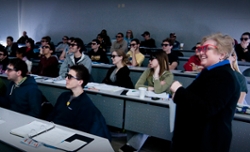Prof. Laura Cayón helps bring 3-D to the classroom
2011-03-10

Kathleen Howell, the Hsu Lo Professor of Aeronautics and Astronautics, has tried a variety of methods for illustrating the 3-D rotation of an object in the unearthly environment of space, a perceptual problem beyond the earthly experiences of her students.
She has used diagrams and 2-D animations. She has stood in front of the class rotating a book in the air with her hands. Yet her students, even when they understand the math, often have a difficult time grasping the concepts behind the calculations.
"You can produce a string of numbers that are all correct and you still have no idea what it means," Howell says.
Now, a classroom with 3-D stereoscopic projection capability resulting from collaboration between faculty members and ITaP is making it easier for Howell's students to grasp the meaning behind the numbers.
Cognitive psychology research suggests that immersive 3-D stereoscopic graphics can enhance teaching, learning and retention, particularly in science, technology, engineering and math (STEM). The technology can be especially useful for understanding concepts that involve scale, relative size, relative position and location of objects, and perspective. But its use thus far has been limited almost entirely to specialized settings rather than typical classrooms.